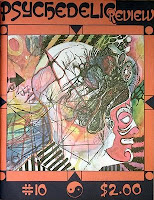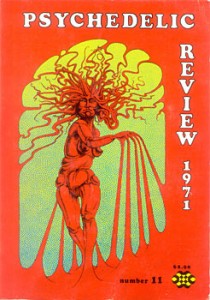We have talked about the Fall 1989 issue of the Whole Earth Review. For aficionados of classic psychedelia, however, there is no substitute for the Psychedelic Review, which was sporadically published from 1963 to 1971, and was excerpted for the book The Psychedelic Reader. The entire run of the journal — eleven issues from 1963 to 1971 — is available online, in PDF format, in the Luminist Archives, and on the website of the Multidisciplinary Association for Psychedelic Studies, where individual articles are also accessible.
 |
By the 1970s, the term psychedelic had acquired indelibly frivolous connotations, but the term had originated, with the best of scholarly intentions, as a way of describing the effects of a number of psychoactive substances considered to be of both intellectual and spiritual importance. The term itself — from the Greek psykhe, mind, and deloun, reveal, make manifest — was proposed in 1956 by the British psychiatrist Humphrey Fortescue Osmond, and first used in a scholarly paper he presented the following year at a meeting of the New York Academy of Sciences.
Aldous Huxley, in an earlier letter to Osmond, had instead proposed the term phanerothyme, from Greek phanero, make visible, manifest, and thymos, soul. In support of his neologism, Huxley offered the couplet, To make this trivial world sublime, take half a gramme of phanerothyme. To which Osmond responded, To fathom Hell or soar angelic, just take a pinch of psychedelic.
The Psychedelic Review was intended to be an intellectually serious publication, begun by members of the Harvard Psilocybin Research Project. It was published and sponsored by Timothy Leary’s International Federation for Internal Freedom, whose purpose was “to encourage, support and protect research on psychedelic substances,” with the goal of increasing “the individual’s control over his own mind, thereby enlarging his internal freedom.” One purpose of the review was thus apparently to provide a scholarly and intellectual predicate for IFIF’s advocacy.
 |
The original editorial board consisted of Paul Lee, Ralph Metzner, and Rolf von Eckartsberg. The announcement of the new journal indicated an intention to publish articles on visionary plants, the neurophysiological aspects of drug action, the epistemology of transcendent experience, the relationship between mysticism and schizophrenia, and other weighty topics. The goal was to publish “original research reports, scholarly and historical essays, outstanding phenomenological accounts of spontaneous or induced transcendent experiences, and reviews of relevant pharmacological and other literature.” Editorial consultants included Richard Alpert, Timothy Leary, Huston Smith, and Alan Watts.
And, indeed, the journal wound up publishing articles not only by its founders but also by such diverse contributors as R. Gordon Wasson, Richard Evans Schultes, Albert Hofmann, R.D. Laing, Sir Julian Huxley, and Alain Danielou, although some of its material was reprinted from earlier sources. Beginning in 1967, in the final three issues, both the covers and the content became visibly more — well, psychedelic. The journal ceased publication in 1971.
As Erik Davis says in his introduction to the 2007 reprint of The Psychedelic Reader, the articles in the review are a time capsule from a different age. Timothy Leary was already embarking on his own unique trajectory; the Psychedelic Review manifests an attitude that I can only describe as high seriousness mixed with a sort of roguish innocence.
When the first issue came out in 1963, a student could subscribe to the first year for four dollars.

- Previous Post: A New Ayahuasca Book
- Next Post: Dealing with Snakebite I
- More Articles Related to: Books and Art, Sacred Plants



I have a copy of Psychedelic Reader in my little library. It is jam packed with really powerful articles.
This is very interesting. I find that that the Mazatec people have this term, ‘duende’ which is meaning the spirits of the mushroom, ‘supernatural dwarves’
What is not mentioned in the book though is the familiarity of this term in Andalusian Flamenco. There are some truly powerfully delicious definitions in this genre for the term duende, and the poet artist Federico Lorca (Google Federico Lorca ~ The Duende)
Also Flamenco muscisans describe the duende as ‘the spirits of the earth’, and when musician, singer, dancer, fuse as one in Flamenco!
My favorite out of the Luminist Archives are the Lisa Bieberman texts, she was a most fascinating woman. I been meaning to write a post about her and Rosemary Leary for some time. IMHO these overlooked psychedelic women pioneers were more interesting that Leary himself.